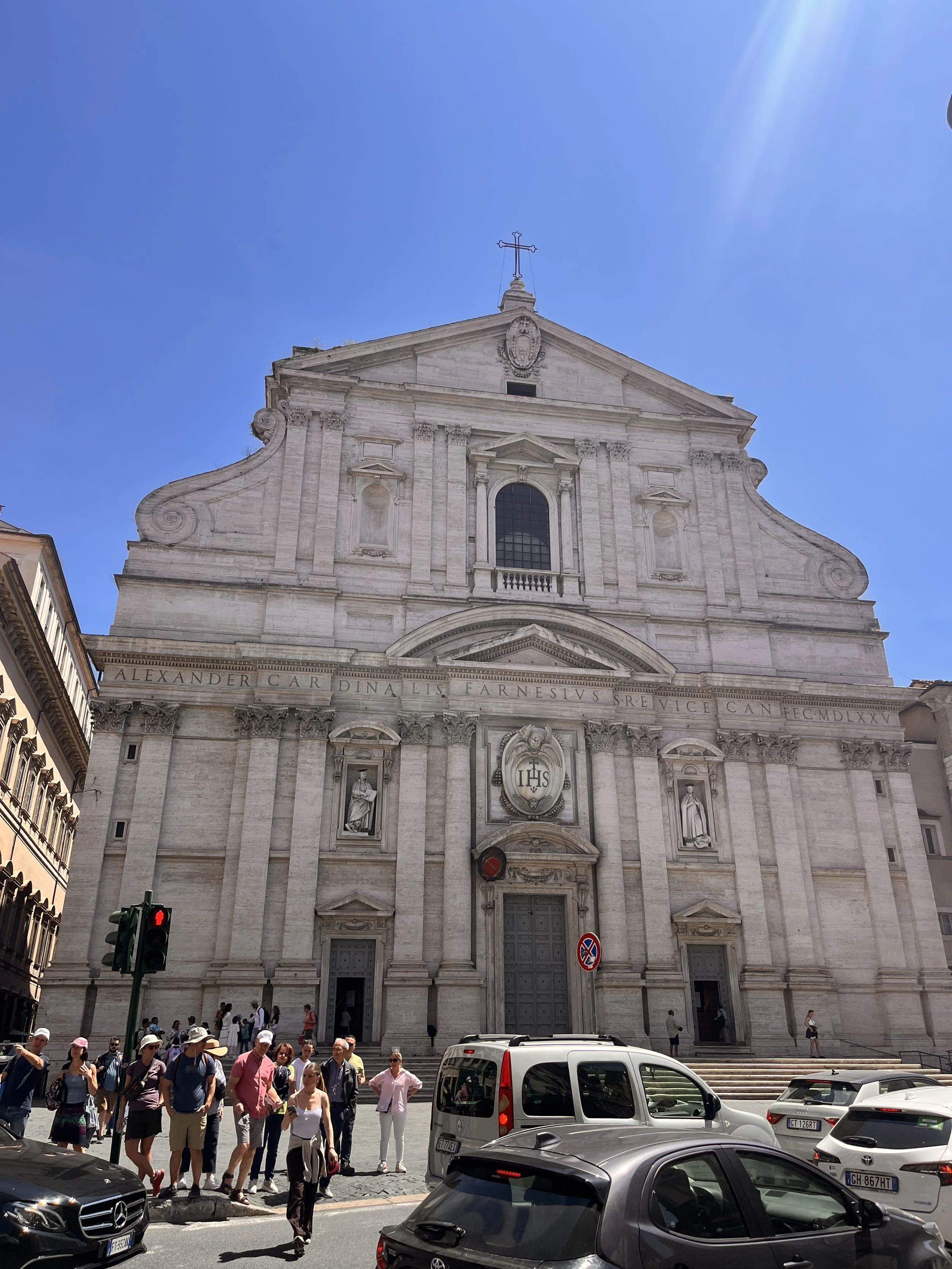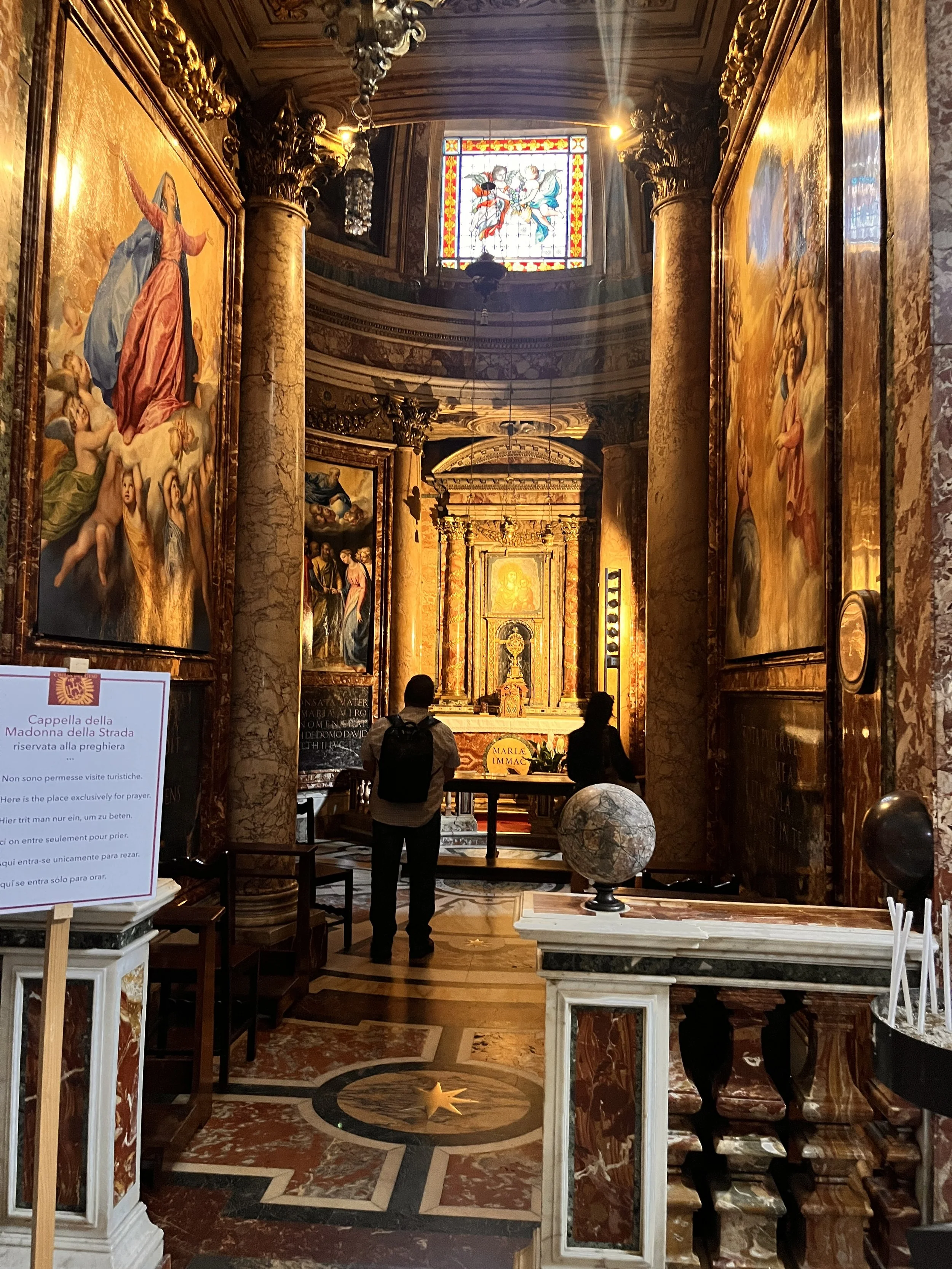Broken Open at the Madonna della Strada
This post is part of my pilgrimage series about Rome.
When I studied in Rome twenty years ago, I learned the city well enough to navigate it without a map. I hoped that inner compass would serve me again after being away for over a decade.
Our flight landed in Rome at 7am, seven hours before hotel check-in. My partner and I wandered through the city jet-lagged in 90-degree heat. The main streets were uncomfortably packed, more crowded and louder than I'd ever experienced. The side streets had always provided a certain solace, a secret it seems that only locals know. Any side street will get you where you need to go (and you might find your new favorite off-the-beaten-path restaurant along the way).
At one point, I told my partner, “I'm turning down the next quiet side street. Follow me.” We wandered through the side streets with no clear destination, but I knew the area well enough to recognize when we were near the Pantheon. From there, I turned to my partner and said, "I think we're close to the Church of the Gesù. That's where St. Ignatius is buried." Off we went.
Church of the Gesù.
A Place I'd Never Noticed
I had never spent much time at Church of the Gesù. It wasn't on my radar back in college or during my last visit 11 years ago. I wasn't studying Ignatian spirituality, and I had no sense that working with discernment leadership would ever be in my future.
Walking into the church, I looked around and spotted Ignatius’s tomb on the left near the front of the main altar. There was a picture of Pope Francis next to it surrounded by candles. I immediately went there to spend time with both of them.
There was an empty kneeler in front of the tomb’s altar. I knelt, a position that felt familiar and foreign. Growing up Catholic, I knelt in church all the time, and when I was younger, I assumed it was the only way to pray. As an adult going through my own formation, I knew kneeling was only one way of many ways to connect with the Divine. I rarely kneel now. Yet, I assumed the position, decades of Catholic tradition guiding me as if on autopilot: kneel while making the sign of the cross, fold hands, pray.
As I took in the altar and St. Ignatius’s tomb, the elaborate artwork above his tomb and the ornate statues seemed to completely counter Ignatius’s simple pilgrim lifestyle. Months before this trip, I was talking with a Jesuit friend about St. Ignatius’s burial spot. He said, “St. Ignatius would have hated it!” Now I could see why. Someone made the choice to glorify him in a way that countered his very mission.
I tried to wrap my head around the fact that the person who had inspired me for the last eight years was lying right in front of me. Time collapsed. I wept. I tried to keep my tears to myself as other people joined me on the kneeler as they followed the same motions I had done moments before.



The Side Chapel
After a few minutes, I looked to the right and noticed a side chapel with a sign indicating it was for private prayer. I didn’t know what this chapel was, but something about it captured my attention completely, like a shiny object I couldn't ignore.
I walked in. It was small, cozy, intimate. Nobody was there.
I looked around at the paintings and frescoes, my eyes settling on one to my left. I don’t even remember what it depicted, but suddenly I felt myself collapsing. It felt like the wind had been knocked out of me. I couldn't stand.
In that instant, all I could think of were the only other two times I had felt like this: The moment I learned that my dad died, a moment I missed by minutes, and the moment I learned my uncle died, a victim of gun violence.
Utterly confused about why those two moments flooded to my mind, I reached out my arms to find something to catch myself. There was a kneeler in front of an icon at the front of the chapel, and I caught myself on it, no autopilot guiding me through the prayer pose this time. I sobbed. I held my head in my hands hoping my sobs wouldn’t echo through the entire church.
I knew there was nobody with me in the chapel, but I also knew I wasn't alone. I continued to weep, looking up at the icon figure in front of me. Through my tear-filled eyes, I could barely make out that it was the Virgin Mary holding Jesus. Even though I was by myself, I heard an unfamiliar voice with a familiar message say, “Build, repair, build, repair.” Other people shuffled in behind me to pray. The steady presence of these strangers supported me as I continued to cry, listen, and receive.
What I Didn’t Know
It was days later when I would learn the historical significance of that side chapel.
We were with our pilgrimage group, wrapping up lunch and getting ready to make our way together to the Church of the Gesù and to the Rooms of St. Ignatius. I heard our group’s professor say we'd be visiting Ignatius's tomb and the Madonna della Strada Chapel.
“Wait,” I said as some faint lightbulb in the recesses of my brain went off. “That is the Madonna della Strada?” Somewhere in my memory, I knew that phrase, that icon, and that chapel held special meaning for St. Ignatius.
Our professor answered, “Yeah, St. Ignatius prayed all the time in front of the icon there. It’s the painting that’s at the very front of that side chapel to the right of his tomb.”
My jaw dropped in disbelief while my gut center felt a deep knowing.
I would later learn that St. Ignatius was a steward of that very icon that I looked at through my tears. The earliest Jesuits prayed in that same chapel before taking their final vows. The chapel has been a place of healing for many people for centuries.
I didn’t know any of that when I stepped in there.
The Madonna della Strada chapel.
Broken Open
Weeks later back home, I met with my spiritual director for our monthly meeting. Throughout our first post-pilgrimage session, I sobbed while recounting my experiences and trying to put them into words. When I told the story of the Madonna della Strada chapel, something clicked.
"I felt like I was broken open.” There was a clarity in that moment that had eluded me for weeks.
We explored that phrase, and I’m continuing to learn more from it. I hesitated even writing about it because it’s not “finished.” The experience has left me with more questions than answers and equal parts frustration and trust.
Here’s what I’ve learned so far:
The scary thing about being broken open is that everything gets let out. I have no idea what's going to come in.
Right now, even though the Madonna della Strada chapel has been a place of healing for people, it doesn't feel like healing – at least not yet. This experience continues to move me to tears. I sobbed as I wrote the first draft of this post. It feels completely uncertain.
But I know that experience in the first hours of our time in Rome prepared me for the two weeks ahead in a way I couldn't have anticipated, including my transformative visit to the Jesuit Archives.
I share this unfinished experience knowing that being broken open is both terrifying and sacred. Perhaps that's exactly the point. We are broken open not because something is ending, but because something is beginning. Sometimes the breaking is the preparation.
P.S. Thanks to my friend Rachel Bloom-Pojar for the reminder that a messy first draft is better than an unwritten one and to my fellow MKE Spiritual Directors for holding this story during a Narrative 4 story exchange.


